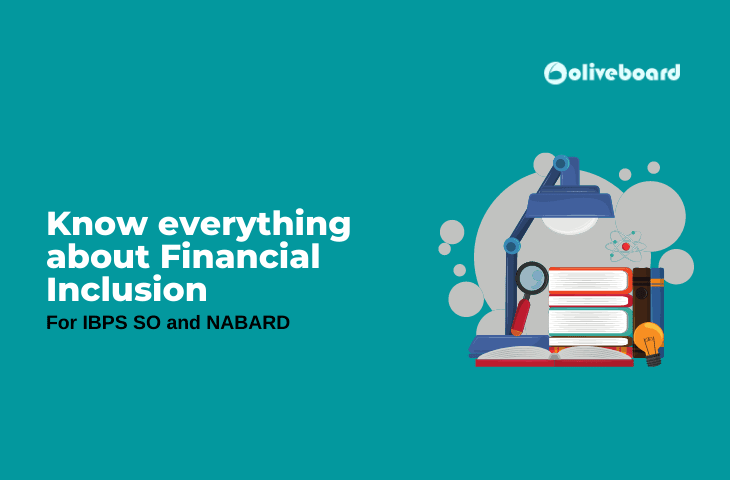Financial Inclusion (FI) is a very important topic for Bank & Government Exams. You can expect questions from Financial Inclusion under the Banking Awareness section of these exams.
In the following article, we have provided the meaning, objectives, and measures taken to achieve Financial Inclusion. We suggest you save it as a PDF and use it as a handy guide for your Banking Awareness preparation.
Financial Inclusion
Download Free eBook Here for IBPS SO
Download Free eBook Here for NABARD
For all Banking exams & other exams like RBI Grade B, SEBI Grade A & NABARD Grade A/B.
1. What is Financial Inclusion?
Financial Inclusion, as the name suggests, is the pursuit of delivering financial services, including payments, savings, credit, etc., to people of low-income and disadvantaged sections of the society at affordable costs. It is also called ‘Inclusive Financing’.
Financial Inclusion’s main objective is to address constraints that exclude people from participating in the financial sector & make financial services available to them to meet their specific needs without any kind of discrimination.
2. Why do we need Financial Inclusion?
A large section of the society still remains unbanked. Unbanked people are people who only have basic transaction bank accounts. These are people who have secured the traditional tools for conducting transactions but aren’t privy enough to digital incorporation of the same.
This has led to a lot of financial instability and pauperism among the people of the lower-income group who do not have access to financial services and products. There are so few banks, especially in rural areas, that these unbanked users carry out transactions either in cash or cheques, making them vulnerable to theft and fraud.
This is why we need Financial Inclusion.
3. What are some of the measures taken to achieve greater Financial Inclusion?
In India, the term Financial inclusion was used for the first time in April 2005 by the then Governor of RBI: Y Venugopal Reddy. There are several measures taken to achieve greater Financial Inclusion, especially by the Government, World Bank, and the Reserve Bank of India, such as facilitating no-frills accounts and GCCs. Here are some of the initiatives were taken:
i. Opening BSBD (Basic Savings Bank Deposit) accounts
The Reserve Bank has advised all the banks to open a basic account with facilities such as no minimum balance, receipt or credit of money through electronic payment channels, ATM cards facilities, deposit and withdrawal of cash at bank branches as well as the ATM.
ii. Relaxation on know-your-customer (KYC) norms
To make the opening of bank accounts easy especially accounts with low balance such as not exceeding 50,000 and aggregate credits in the accounts not exceeding rupees 1 lakh a year. Banks are also allowed to use Aadhar card as proof of address and identity.
Domestic Scheduled Commercial Banks (SCBs) are permitted to open branches in Tier-2 to Tier-6 centers with a population under 1 lakh under general permission subject to reporting, to address the issue of uneven spread of bank branches. In North-eastern states and Sikkim, the domestic SCBs can open branches without permission from the RBI.
iii. Opening branches in unbanked rural areas
RBI has directed banks to allocate at least 25% of their branches to be opened in Tier-5 and Tier-6 centers during the year.
iv. Licensing of new banks
The business models aimed at furthering financial inclusion would be looked into closely in processing applications for bank licensing.
The RBI also urged banks to review their existing objectives and practices in order to align them with the objectives of Financial Inclusion. It also permitted banks to use NGOs and SHGs, microfinance institutions, and civil society organizations as intermediaries to facilitate financial and banking services.
RBIs vision for 2020 is to open nearly 600 million new customers’ accounts and service them through a variety of channels by leveraging on IT.
Download Free eBook Here for IBPS SO
Download Free eBook Here for NABARD
v. What are some other measures taken?
- Thanks to the use of technology in the Finance industry, the void of inaccessibility to Financial services has been filled.
- Mangalam in Puducherry became the first village in India where all the households were provided with facilities of Banking.
- General Credit Cards (GCCs) were issued to the poor, low-income group and disadvantaged to help them access easy credit.
- A 100% Financial Inclusion campaign was launched by commercial banks in different regions. This resulted in states or UTs like Puducherry, Kerala, and Himachal Pradesh announcing a 100% financial inclusion in their districts.
- Many startups were launched to work towards increasing Financial Inclusion. For instance, Fintech is working to create mobile payment and micro-lending facilities for financially underbanked users.
- There are many online payments and mobile payment services to facilitate the ease with which unbanked people can immerse themselves in the digital economy, like AliPay and Paytm, and foster financial inclusiveness.
- These companies have also come up with innovations to promote transparency in their dealings with customers to gain their trust.
Financial Inclusion Initiatives in India
In a bid to broaden the scope of financial inclusion, the central government of India has implemented various schemes. These initiatives have been meticulously devised through extensive planning and research, with input from financial experts and policymakers. Notable financial inclusion schemes include:
1. Pradhan Mantri Jan Dhan Yojana (PMJDY)
2. Atal Pension Yojana (APY)
3. Pradhan Mantri Vaya Vandana Yojana (PMVVY)
4. Pradhan Mantri Mudra Yojana (PMMY)
5. Pradhan Mantri Suraksha Bima Yojana (PMSBY)
6. Sukanya Samriddhi Yojana
7. Jeevan Suraksha Bandhan Yojana
8. Credit Enhancement Guarantee Scheme (CEGS) for Scheduled Castes
9. Venture Capital Fund for Scheduled Castes under Social Sector Initiatives
10. Varishtha Pension Bima Yojana (VPBY)
11. Kisan Credit Card (KCC)
The Kisan Credit Card scheme, introduced in 1998, aims to fulfill the production credit needs of farmers promptly and efficiently. The objectives of the KCC scheme include:
1. Providing timely and adequate credit assistance from the banking system to farmers under a unified platform.
2. Covering purposes such as short-term credit for crop cultivation, post-harvest expenses, produce marketing loans, working capital for maintaining farm assets, investment credit for agriculture and allied activities, and consumption requirements of farmer households.
Eligibility for the Kisan Credit Card extends to a diverse group of farmers, including individuals, joint borrowers, proprietary cultivators, tenant farmers, sharecroppers, oral lessees, and self-help groups or joint liability groups involved in farming activities.
We hope the above gives you a fair idea about Financial Inclusion, why it is needed, and what are the measures taken to achieve it. Save this as a PDF to use it as a handy guide for your Banking Awareness preparation for Bank and Government exams.
For more topics, questions, and lessons on Banking Awareness click here: Banking Awareness for Bank and Government Exams.
- IBPS PO Exam Date 2024 Out, Check the Detailed Schedule
- SBI Clerk Mains Syllabus 2024 & Exam Pattern, Download PDF
- SSC Selection Post Phase 12 Exam Date 2024, Revised Schedule
- SBI PO Notification 2024 and Exam Date, Check Details
- SBI PO Salary 2024, Pay Scale, Salary Structure

The most comprehensive online preparation portal for MBA, Banking and Government exams. Explore a range of mock tests and study material at www.oliveboard.in
Oliveboard Live Courses & Mock Test Series




